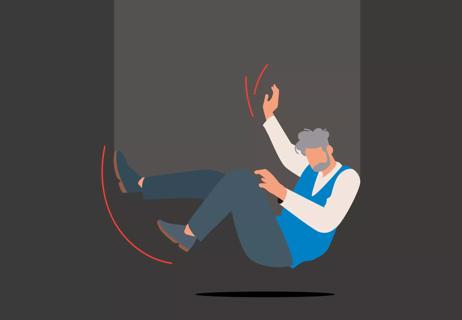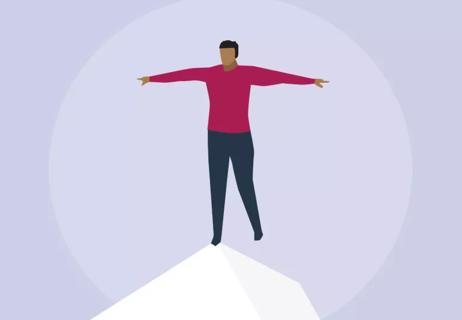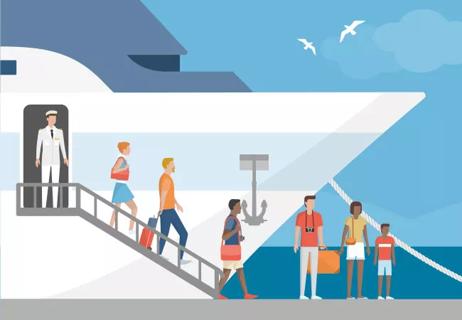Building lower body strength is key to staying upright, particularly as you age

More than 3 million older Americans land in the emergency room every year as a result of a fall, making it the leading cause of injury and injury-related death for adults aged 65-plus.
Advertisement
Cleveland Clinic is a non-profit academic medical center. Advertising on our site helps support our mission. We do not endorse non-Cleveland Clinic products or services. Policy
Exercises that improve balance can help reduce your chances of falling. A few minutes a day is all it takes to gain steadiness and move with more confidence, say exercise physiologists Katie Lawton, MEd, and Christopher Travers, MS.
Here’s how you can do it.
As you age, you begin to lose muscle mass and strength. Your reaction time also slows. “These are all things that affect your balance,” says Travers. “As a result, you’re more susceptible to trips and falls.”
But those natural physical declines don’t have to be steep. Staying active and exercising regularly can help keep you fit and steady on your feet as the birthday candles add up.
For balance, it’s important to maintain lower body strength: “You really want to target your bigger muscle groups, your primary movers, like your glutes, hamstrings, quads and core,” adds Lawton.
Here are some balance exercises and programs to work into your daily routine.
The tandem stance balance exercise is essentially heel-to-toe walking in a straight line. To do it:
Advertisement
“Don’t rush through it. It’s not a race,” advises Travers. “Just focus on staying as steady as you possibly can with each step.”
If you’re worried about falling, use a wall or sturdy support for assistance.
Standing on one leg can be more difficult than it sounds — and it’s a great way to judge where you’re at with balance. There’s even a theory that your ability to stand on one leg reflects how long you might live!
Here are three variations to try.
It’s OK to put your arms out to help with balance as you do any single-leg stance, too. “They can act as a counterbalance if you feel wobbly,” says Lawton. “As you keep doing this, though, you may find you don’t need to use them as much.”
Consider using a chair to potentially hold for extra support when you first start, too.
Standing on your tippy toes strengthens smaller muscles in your feet, ankles and calves to increase stability. To work these muscles:
Getting up out of a chair works more lower-body muscles than you’d expect, especially if you don’t use your arms to push or pull yourself up. To do this exercise:
Advertisement
Stepping up onto a step or stable platform requires strength and coordination, two attributes that keep you balanced. Here’s how to “step up” your lower-body workouts.
If you’re looking for a more structured program that can help you build balance, consider trying any of these activities:
And no matter how simple these exercises and programs may seem, it’s always a good idea to talk to your healthcare provider before beginning any exercise routine.
Once you get the go-ahead, dedicate yourself to daily activity to stay fit and nimble.
“Staying active is maybe the most important thing you can do to retain your balance,” reinforces Lawton. “As people get more sedentary, we see more deterioration between your neurological system and your muscles. If you don’t use it, you lose it — and that’s when falls become more likely.”
Advertisement
Learn more about our editorial process.
Advertisement

A study found that you might live longer if you can stand on one leg — but it’s far from a perfect indication of longevity

Staying active and doing what you love may increase both your confidence and your balance

Is it clumsiness or something more serious?

Exploring mal de debarquement

Physical activity can help preserve and improve your cognitive function and fend off dementia, stroke and other health concerns

Lower-intensity workouts can deliver high-quality health and fitness results

Incremental changes in your exercise routine can improve your strength and endurance over time

Understanding heart rate zones can help you tailor your workout to reach your goals

Babies can get congested easily, but you can calm their cough by keeping them hydrated, using nasal drops and running a humidifier

Weight loss may cause loose, sagging skin and muscle loss to your rear

Several conditions, like vitiligo and fungal infection, can cause a loss of pigmentation, leading to white spots or patches on your skin